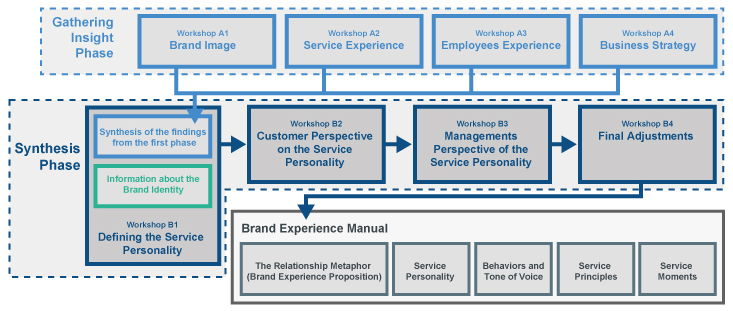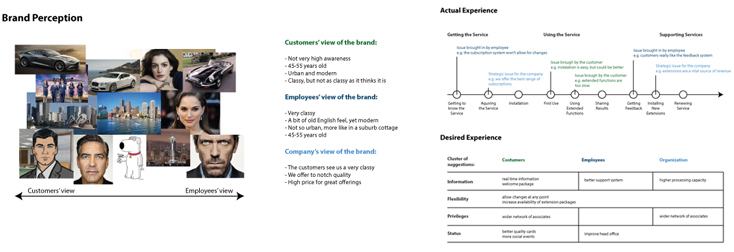Brandslation and Brand Experience Manual
The design of brand-based interactions is not new; service designers have been embedding brand characteristics into touch-points for more than a decade now. Yet, one problem persists: as there is no shared understanding of the experience proposition the brand is making, every new design team will develop service touch-points based on their own understanding of the Brand Experience Proposition; as these different interpretations are embedded in the service interactions, the customer’s experiences with the brand will consequently be inconsistent.
This section presents the Brandslation process as a framework that helps organizations define and communicate their Brand Experience Proposition, avoiding the multiple interpretations aforementioned. As it is argued in the Theoretical Background section, in Designing for Brand Experience, the organization is actually trying to reinforce the customer’s relationship with the brand by delivering the Brand Experience Proposition through Brand based Service Interactions.
It is thus suggested that by informing the design teams what experiences they are designing for should facilitate the process of developing Brand based Service Interactions. As the outcome of the Brandslation process, the Brand Experience Manual uses a relationship metaphor as a way to make the Brand Experience Proposition easier to communicate, enabling the service design teams to develop Brand based Service Interactions, even across different projects.
This section describes the Brandslation process (Image 1) as a series of workshops divided into 2 phases – gathering insight and synthesis; and suggests the content for the Brand Experience Manual as the outcome of the process. As it is further explored in the Theoretical Background section, branding can be divided into defining the brand proposition, and delivering the brand; accordingly, the presented process help organization to understand what their experience proposition is, and through the proposed Designing for Brand Experience approach, enable the delivery of the Brand Experience Proposition.

Image 1 – Visual representation of the Brandslation process and the Brand Experience Manual
Gathering Insights Phase:
As a service design process in itself, Brandslation is proposed as a co-creative and transdisciplinary framework that develops the Brand Experience Proposition based not only from the organizations perspective, but also considers the employees and customers perspective. As such, this phase aims at understanding the existing perceptions of the brand, the current the experiences with the service interactions, and the expectations for the future from the point of view of the customers, employees and the organization.
As service experiences result from the interaction of multiple stakeholders in the co-creation process, as many different perspectives, and as many stakeholders as possible. It is suggested that mid-section reports are made throughout the process as a way to facilitate the outcome, which is a visual summary of the findings from this phase that can the used in the next phase’s workshops (Image 2).
– Workshop A1 – Brand Image: The focus of this first workshop is to assess the customer’s perception of the brand. In that occasion, long-term customers should be invited to discuss for their lasting relationship with the brand; the service experience and expectations for the future should also be discussed.
– Workshop A2 – Service Experience: The second workshop focuses on understanding the current experiences of the customer’s. At this stage, the customers group interacting with the service the most should be invited. Pre-interviews should be arranged to develop a deeper understanding of the customer’s journey, and the outcomes from the interview can be discussed in the workshop. The brand image and expectations for the future should also be explored.
– Workshop A3 – Employees Experience: This workshops focuses on the employee’s perception of the brand, their experience in interacting with the customer, and their insights in terms of limitations imposed by the service systems. During this section, it can also be expected that a substantive amount of customer insight will be indirectly obtained due the employees’ involvement with customers.
– Workshop A4 – Business Strategy: It is suggested that thus workshop should take place last, so the teams running the workshops can come to the discussion with customers insights already analyzed. The conversations should focus on business model, brand strategy and positioning of the company; also, in having some customer insights, the business positioning should be discussed, and doubts about the alignment between business and brand should be clarified.
Image 2 – Example of outcome from the Gathering Insight Phase (click to enlarge)
Synthesis Phase
This phase synthesizes the insights from the previous phase into content for the Brand Experience Manual. The main outcome is the development of a relationship metaphor for the Proposed Brand Experience, which is to be communicated through the Brand Experience Manual. Also, it has been noticed through the research process that this phase not only enables the development of the analogy for the Proposed Brand Experience, but it also helps the organization to review their brand positioning.
The first step for this series of workshops is to organize the findings from the first phase in the form of Brand Perception, Service Experience, and Desired Experiences from the perspective of all stakeholders researched. Also, it is important to gather information about the current brand identity, as it will be used in the first workshop of this phase.
– Workshop B1 – Defining the Service Personality: Together with the marketing and management teams, a discussion about who/what the brand really is should take place first. Once the brand is understood, the insights gathered in the first phase are put in perspective in relations to the brand through a movie analogy; the insights are translated into the movie’s scenes, where the two main characters are the brand and the customer. As the workshop group gets more acquainted with the brand character, the insights from the first phase should be further explored and organized (Image 3), until clusters of personality traits and relationship characteristics emerges. At this point, it is important to develop the discussion as much as possible, as it will help to understand the dynamic between the service personality of the brand and the customers.
Image 3 – Example of how to organize the findings from the “Defining the Service Personality” workshop (click to enlarge)
– Workshop B2 – Customer Perspective on the Service Personality: Together with customers, this workshop has 2 functions: asses if the Service Personality resonates with the customers; and understand how the customers expects this personality to behave in a service interaction, and how they expect this brand relationship to develop.
– Workshop B3 – The Management Perspective of the Service Personality: Having the customer’s insight from the previous workshop, a similar process is done with the marketing and management teams; throughout the workshop, some characteristics of the personality and the relationship where discussed in the light of customer’s insight, and aligned with the business strategy.
– Workshop B4 – Final Adjustments: As the core of the Brand Experience Manual is, at this stage, already developed, the in-progress material should be organized and presented to the marketing and management teams as a way to fix any misalignment between the brand experience proposition and the business strategy.
It might not be clear in description, but the relationship metaphor starts to emerge as early as in the first workshop of this second phase, and it develops throughout the process. During the research process it was commonly suggested that when in doubt about the how the brand should behaviors to just “ask the dude”; meaning, in doubt, try to imagine what the brand “character” would do.
As such, it can be seen that this process does not only help to develop a service personality, but a full character, with a relationship history with the customer, a name, age, and a set of typical behaviors. It is this set of insights, so clear for the teams involved in the process that must be communicated through the Brand Experience Manual. In the next subsection the content of the Brand Experience Manual described, explaining what the outcome of the process should be, and how it can be organized.
The Brand Experience Manual
Put in a simple way, the Brand Experience Manual is the outcome of the Brandslation process. It is the translation of the brand strategy into a customer experience proposition, which is presented in an easy and understandable way. The Proposed Brand Experience is communicated through a relationship analogy; the experience the organization wants to deliver during the customer’s continuous interaction with the Brand Character.
Below, a suggested structure for the manual is presented, which should also help to explain what the outcome of the Brandslation process should be.
– The Relationship as a metaphor for the Brand Experience Proposition is the core of the Brand Experience Manual; it is expressed as how the brand character and the customers persona interact with each other, and their relationship history – e.g. how thy met, who they are to each other – helping to explain what is the long-term perception the brand is wants the customer to have. Also, a Service Experience Statement defining what the goals are can be used to summarize the desired relationship in a shorter description. At this level, the Brand Experience Proposition should not only be a reflex, but also influence the value proposition the organization is making to the customers.
– The Service Personality is central for the Brandslation process helping to define who the Brand Character is; although it is just a part of the relationship metaphor, it is a central one as it defines whom the customer is interacting with. The service personality can be organized as a set of traits, yet, it is important to give some depth to these descriptions, as just stating a personality trait doesn’t explain much; word carry different meanings, and it is the interpretation of these meaning that matters.
– The Service Behaviors, which also comprises the Tone of Voice, describes the typical manners of the Brand Character, it explains the ‘how’ of the service interactions, making it easier to understand how the touch points should perform in order to communicate the Brand Experience Proposition.
– The Design Principles describe consistent behaviors that help the to communicate the Brand Experience Proposition through all service interactions. It is based on the analysis of how the brand is perceived and who it wants to be, helping to bridge the gap between brand image and brand identity by describing key actions that must be considered in the design process.
– The Service Moments are examples of how the Customer Journey would be as the Brand Experience Manual are applied through the service settings; it is a set of scenarios meant to clarify the Proposed Brand Experience through examples.

Image 4 – Proposed structure for the Brand Experience Manual
This content framework is just a suggestion based upon two iterations of the manual. In future developments, the items as presented might be merged to allow for greater simplicity; yet, these are the elements that should somehow be presented in order for the relationship metaphor to be communicated in the most accurate and yet understandable way possible. Also, this research was developed in a medium sized company; as such, the application of the process for in more complex organizations will require adaptations.
Notes:
Brandslation is a registered trademark of the Oslo School of Architecture and Design
For more on the topic, go to http://designresearch.no/people/mauricy-filho
Special thanks to Simon Clatworthy, Johan Blomkvist and Paulo Peres for the help reviewing the text.





